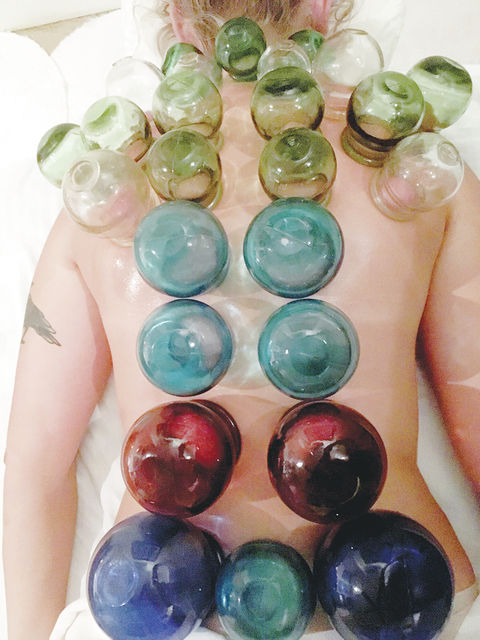Mysterious circular bruises on the shoulders of swimmer Michael Phelps at the Olympics Games have propelled an ancient medicinal technique to the modern world’s center stage. The art of cupping is akin to massage. However, instead of pressing down on
Mysterious circular bruises on the shoulders of swimmer Michael Phelps at the Olympics Games have propelled an ancient medicinal technique to the modern world’s center stage.
The art of cupping is akin to massage. However, instead of pressing down on the body’s tissues, the goal is to do the opposite – to pull up the tissues and allow fresh blood circulation deep within the muscles.
“Cupping feels like a gentle suction is pulling away tension from tight and painful areas of the body,” said Christine Walinch, a Hawaii licensed acupuncturist and Chinese cupping specialist in Kilauea.
Cupping creates space between tissue layers and provides the opportunity to expel dead cellular debris, as well as excess fluids and toxins. It also breaks up scar tissue.
“The marks, then, are caused by this debris being pulled up and deposited under the skin, which is actually the most effective place for the lymphatic system to drain it away,” Walinch said.
Those dark marks are more prevalent with one of the two popular types of cupping techniques — the stationary cup technique. In that technique, several cups are placed in the treatment zone for 5 to 10 minutes.
The other technique is gliding. In that method, oil is applied to the skin and the cups are moved across the body, generally along the meridians.
Gliding cups don’t provide steady suction in one particular location, so the chance of getting bruises from the cups themselves decreases.
Walinch combined the two techniques when she practiced cupping therapy on this TGI reporter, and after a full session there was only one dark circular bruise that showed up at the base of my neck.
“Cupping can leave circular marks on the skin that range from a light yellow to pinkish red, to dark purple,” Walinch said. “From an acupuncture perspective, the darker the marks, the more stagnation of qi and blood in that area.”
She continued: “Stagnation leads to pain and dysfunction within the tissues, so cupping — like acupuncture — aims to clear the stagnation before it causes problems.”
Cupping is just as relaxing as getting a massage.
There are two methods for using the cups themselves, which are various sizes and made from glass — cups with suction on them that pull the oxygen out of the cup once it’s on the skin, and the traditional fire cup method.
Walinch uses the fire cup method, which requires heating the inside of the glass cup with a flame before placing it on the skin. It feels warm, inviting and doesn’t hurt.
Most who practice the art of cupping attribute it to Chinese medicine. However, Walinch said there’s evidence this sort of reverse-massage treatment dates back to ancient Egypt.
“Cupping decompresses adhesions and scar tissue, relaxes muscles in spasm, decreases trigger-point pain, and decreases tissue changes and inflammation following trauma,” Walinch said. “Cupping can affect tissues up to four inches deep; impacting blood vessels, fascia, muscles and scar tissue.”
The practice also increases range of motion, breaks up adhesions, helps with circulation and promotes healing in chronic injury sites.
Cupping is helpful for many ailments, Walinch said, like tight and stiff muscles, back pain and sciatica, and stress.
It’s important to remember that cupping opens the pores, Walinch said, so the body is more susceptible to catching a cold if exposed to extreme changes in temperature immediately after treatment.
“It resets the nervous system,” Walinch said, ” … and leaves the person with a sense of well-being and lightness.”
That was certainly the case for this patient, who left the Kilauea Stone House where Walinch practices, feeling lighter and relaxed.
To contact Christine Walinch, call 808-351-6374, or visit her website at acupuncture888.net.



